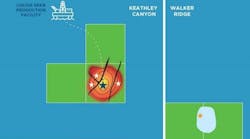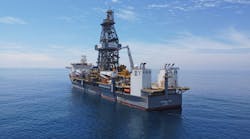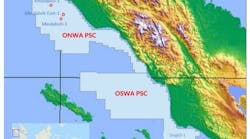The global offshore oil and gas industry has three major deepwater plays: the Gulf of Mexico, Brazil, and West Africa. Operators have invested and will continue to invest in these plays because they are more established in terms of history and technology, offer relatively low risk, and hold plentiful reserves. But contrary to popular views, oil and gas do exist below the 1,500-ft threshold in other areas of the world, and several companies have been keen on capitalizing on it.
Countries like Indonesia and Egypt have recently been making some substantial finds in their relatively unexplored deepwater acreage. This has attracted the interest of sizeable producers, who are making substantial investments.
Indonesian strikes
The hottest "non-big three" deepwater theater has proven to be the Asia-Pacific region, specifically offshore East Kalimantan, Indonesia. Unocal has an established deepwater operation there, with five production sharing contracts (PSC) holdings: East Kalimantan (100%), Ganal (100%), Sesulu (100%), Rapak (70%, Mobil 30%), and Makassar Strait (50%, Mobil 50%).
The company has drilled 10 deepwater wells since the beginning of this year in its various holdings, with eight of ten being successful. Within the Makassar Strait and East Kalimantan licenses, the company holds two major deepwater oil and gas fields: Merah Besar and West Seno.
Discovered in 1997, Merah Besar was the first deepwater oil and gas field discovered off Indone sia. The field lies in over 2,000 ft water depth and bridges both the East Kalimantan and Makassar Strait PSCs in the deepwater area of the Maha kam Delta. Approximately 10 wells have been drilled on the greater Merah Besar structure, eight of which have been successful, and the company has estimated the field to hold a gross resources potential of 75-300 million boe. Produc tion plans are to tie-in Merah Besar as a satellite to the other major field in the area, West Seno, by 2001.
West Seno is approximately 13 miles northeast of Merah Besar in the Makassar Strait PSC in the deepwater Kutei Basin in 2,800 ft water depth. The initial discovery was made last year through a 50-50 joint venture of Unocal and Mobil. The West Seno Field is estimated to hold around 150 million bbl of oil with a gross discovery volume ranging of 210-720 million boe. With this great potential, West Seno was pushed ahead of Merah Besar as the first planned deepwater development in the area and was given fast-track status. Delineation work has been completed, and plans are to drill deeper targets within the field during development. The companies anticipate using a TLP for this development.
More recently, Unocal struck pay again and added to these two fields with the Janaka North discovery in the Rapak PSC. Janaka North is approximately 3.5 miles northeast and southeast of Merah Besar and West Seno, respectively, and was drilled in 4,319 ft water depth. The well marks the deepest water depth well drilled off Indonesia to date. The well encountered 50 ft of high quality reservoir with porosities greater than 35% and has been praised by Unocal as some of the best quality reservoir drilled to date.
The company is now drilling three prospects on the deepwater Ganal PSC and will drill additional wells on Rapak later this year. By the end of this year, Unocal intends to be drilling in over 6,000 ft water depth off Indonesia to "test the highly prospective portion of the firm's Indonesia exploration portfolio that lies in deeper water," according to a company representative.
Egypt's potential
Egypt is another area with a deepwater frontier that is beginning to take shape. Operators have begun going deeper and deeper into the Mediter ranean Sea in search of plentiful gas reserves that exist on land, including the Western Desert region of Egypt. British Gas (BG) has been spearheading exploitation of this region. The company has drilled several successful deep water wells in the West Delta Deep Concession in the Mediter ranean Sea with partner Edison International.
Most recently, BG tested 44 MMcf/d of gas from the Simian-1 well in the concession. The well was drilled in 1,900 ft water depth. Simian-1 was the sixth well drilled in the concession. All have encountered significant quantities of gas. Earlier wells discovered the Saffron/Scarab Field in 1,900 ft water depth. The first two wells on this field, Scarab-1 and Saffron-1, set two records for the highest flow rate and for drilling in water depths greater than 1,900 ft in the Egyptian sector of the Mediterranean.
BG also struck gas with the P12/13 discovery in the concession in May. Along with Simian-1, the company plans for further development of the area. Development plans for the Saffron/Scarab Field are being finalized and will be the first deepwater field in production off Egypt. The company has submitted a bid to use LNG from the region to supply to Turkey and will also distribute the gas along the Nile Valley.
Activity is about to pick up as well from other players. Wavetech Geophysical is in the process of acquiring 2,925 km of high-fold, long offset seismic data over the entire extent of the Egyptian offshore, including deepwater.
BP Amoco and Elf has also planned 10-well, $310 million exploration program in the 15,000-sq km ultra-deepwater Block B, now called the West Mediterranean Deep Marine Block. BP Amoco will be the operator and seismic will begin this year. The companies hold the concession for a 13-year term.
Shell has planned a $210 million drilling program on the Northeast Mediterranean Deep Marine Block. In addition, Egypt has five offshore Mediterranean blocks on offer in the country's latest bid round. The round includes a total of 15 blocks and will close on October 31st.
Israel prospect
Israel has also jumped into the deepwater with a new discovery in the Mediterranean Sea. Samedan and partners Avner Exploration, Delek Drilling, and RB Mediterranean, drilled the Noa-1 well in 2,555 ft water depth on the PL 273 exploration license. The well tested at a rate of 30 MMcf/d of gas through a 3/4-in. choke with 2,200 lb flowing pressure.
PL 273 is one of nine licenses the companies hold covering 890,000 acres in water depths, ranging from 2,500 ft to 5,000 ft. A second well is in progress in the area by Isramco on the Med-Yavne license. This well is in 2,525 ft water depth and is being drilled using the Atwood Eagle semisubmersible.
According to seismic shot in the area, the Israe* offshore geololgy is considered to be analogous to that offshore Egypt, specifically holding similar anomalies to those of the recent deepwater gas discoveries.
Malaysia interests
Malaysia has entered the deepwater game with a discovery by Shell in the deepwater Block G offshore Sabah (Borneo province). The Kamunsu East-1 well was drilled in 2,417 ft water depth and was the country's first deepwater exploration well. The well encountered a thick a section of gas pay with oil indications in stacked sandstones, which the company has deemed commercial.
Shell has the majority interest in the Sabah deepwater blocks with partner Petronas. But another player, Murphy Oil, has secured interest in another deepwater block, Block K. The company will perform new 2D and 3D seismic in the block and has planned to drill one well.
India prospective
India is also hedging for a deepwater play. State-owned ONGC has made the first deepwater discovery in the country's Bay of Bengal. The well G-1AA in the Krishna-Godavari Basin flowed 3,600 b/d of oil and 1.4 MMcf/d of gas.
The country hopes this find will attract more interest to the area, especially in trying to attract companies to India's latest licensing round. The round is the first offering of blocks under India's New Exploration Licensing Policy (NELP) and offers 12 deepwater blocks and several incentives for deepwater exploration. However, interest in the round has been low, thus far.
Trying, failing, hoping
Several other countries are trying for deepwater plays, with wells underway:
- Turkey: With the first of two deepwater exploratory wells in the western Black Sea, Turkey is moving into deepwater. State-owned Turkish Petroleum and Arco are drilling the Limankoy-1 and will drill the Limankoy-2 well, targeting gas. Limankoy-1 is drilling in 2,788 ft water depth and Limankoy-2 will be in 2,296 ft. The Sedco 700 semisubmersible is being used for the project.
- Australia: Australia is also pushing for a big deepwater play. WAPET has contracted the refurbished Marine 500 deepwater semisubmersible to drill three deepwater wells on the Gorgon gas field offshore Western Australia. The wells are planned for water depths over 4,000 ft, close to the deepest water depth ever drilled in Australia. The first well will drill in the WA-205-P license, while the second and third will be in the WA-267-P license.
- New Zealand: While these plans are going through, other areas have seen recent failure. Conoco tried for a deepwater play off New Zealand using its new Deepwater Frontier ultra-deepwater drillship. The company drilled deepest well ever off New Zealand, well Waka Nui-1, in 4,812 ft water depth on the PEP 38602 permit in the Northland Basin. How ever, the well came up dry and the rig has since moved out of the area. Conoco and partners Inpex and Todd are committed to drill a second well on the permit by 2003 as part of the license.
- Norway: Norway also came up unsuccessful with its deepest well ever on the Norwegian Continental Shelf. Saga drilled the 6704/12-1 well in the Gjallarryggen area in 4,400 ft water depth. The well encountered some hydrocarbons, but not in commercial quantities. Gjallarryggen was also the last of six licenses hoping to find a new large oil field in the Norwegian sector.
Then there are those countries hoping to enter the deepwater. Many operators are waiting:
- Faroe Islands: One of the most anticipated is the Faroe Islands whose offshore acreage has been in a long-running dispute with the UK over the maritime boundary. This is expected to be cleared up and open for bidding later this year, and will offer high potential deepwater acreage in the North Atlantic.
- Greenland: Also in the North Atlantic is a highly-prospective license off Greenland. Statoil, Phillips, Dopas, and Nunaoil will begin drilling on the 3,900 ft water depth Fylla license next year. The license covers 9,487 sq km and is the first award granted off Greenland since the 1970s.
- Guyana: A further new player is the small South American country Guyana. Exxon's Esso affiliate has signed a production sharing contract for the first deepwater acreage off the country. Esso has been granted the 15 million-acre Stabroek Block in water depths from 650 to 10,000 ft.
These deepwater plays are still in their infancy and have yet to yield the quality of finds that have put the Gulf of Mexico, Brazil, and West Africa on the top of operator's lists. But, the plays are sizeable enough to attract interest and will likely grow to substantial developments in the future, although they will most likely never escape the shadow of the big three.




